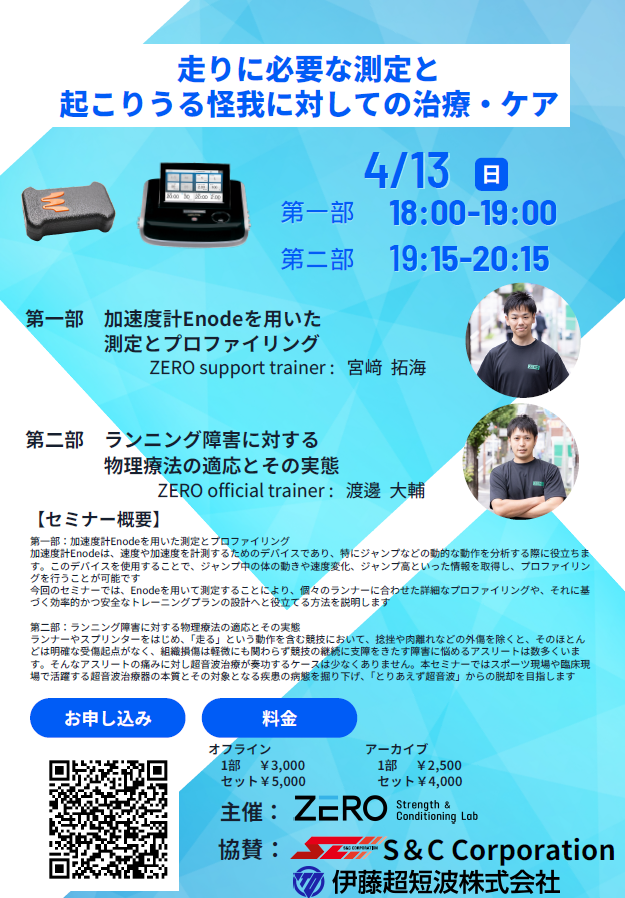最大筋力を向上させるためのVelocity Based Training Part.1
2020/08/07
ストレングス&コンディショニング業界におけるVBT(
Velocity Based Trainingの基本と要点
1.負荷と速度の関係
ウエイトトレーニングにおいて、

2.最小速度閾値( The Minimum Velocity Threshold )
ウエイトトレーニングにおいて、
最小速度閾値(MVT)と呼ばれるこの値は、


(図2)・ベンチプレスにおいて実測で1RMを測定した際の負荷と挙上速度の関係・80%1RMでつぶれるまで反復を行った際の速度とMVTを表したグラフ
ここで注意すべき重要な点は、
これら2つの基本原則、「負荷と速度の関係」と「
1.努力度の測定と漸進的な過負荷の管理
2.最大下負荷を用いて1RMを推定する
3.筋力プロファイリング
4.疲労と努力レベルのコントロール
5.筋力特性の変化をモニタリング
最大筋力向上を目的としたVBT
1.努力度の測定と漸進的な過負荷の管理
今回採用した戦略の中で、
最大負荷を挙上することはほとんどありませんでしたが、

(図3)推定1RMを算出するための計算式
重量-
翻訳
S&C株式会社 齋藤朋弥・長谷川裕
VBTを実践できる機器はこちら!
GymAware:VBTデバイスのゴールドスタンダードと呼ばれるほど、高い精度を誇り、世界中で使用されています。
http://sandcplanning.com/solution/category/detail/?cd=1
PUSH2.0:小型でシンプルな使用方法から、近年注目を集めているVBTデバイスです。リモートコーチングにも使用されています。
http://sandcplanning.com/solution/category/detail/?cd=2
Velocity Based Training ベーシックセミナー 動画販売開始のお知らせ
この度、Velocity Based Training ベーシックセミナーの販売を開始いたしました。
本セミナーではVBTについて基礎理論をご紹介いたします!
Velocity Based Training:VBT とは何か?
VBTの背景や元となった研究、トレーニングの実践例まで順を追って説明いたします。
これからVBTを行いたいと思っている方、基礎的な理解をさらに深めたい方に必見のセミナーです!
※本セミナーはVBTの理論をご紹介いたします。実技等はございませんので予めご了承ください。
セミナー動画のご購入につきましては、下記URLのページ下部をご確認ください。
http://sandcplanning.com/solution/category/detail/?cd=53
参考文献
- Bosquet, L, Porta-Benache, J and Blais, J. Validity of a commercial linear encoder to estimate bench press 1RM from the force-velocity relationship. J Sports Sci and Med 9, 459-463, 2010.
- Conceicao, F, Fernades, J, Lewis, M, Gonzalez-Badillo, JJ and Jimenez=Reyes, P. Movement velocity as a measure of exercise intensity in three lower limb exercises. J Sports Sci [Epub ahead of print], 2015.
- Folland, JP, Irish, CS, Roberts, JC, Tarr, JE and Jones, DA. Fatigue is not a necessary stimulus for strength gains during resistance training. Br J Sports Med 36: 370-74, 2002.
- Gonzalez-Badillo, JJ and Sanchez-Medina, L. Movement velocity as a measure of loading intensity in resistance training. Int J Sports Med 31:347-52, 2010.
- Gonzalez-Badillo, JJ, Marques MC and Sanchez-Medina, L (2011). The importance of movement velocity as a measure to control resistance training intensity. Journal of Human Kinetics, Special Issue 2011, 15-19.
- Izquierdo, M, Gonzalez-Badillo, JJ, Hakkinen, K, Ibanez, J, Kraemer, WJ, Altadill, A, Eslava, J and Gorostiaga, EM. Effect of loading on unintentional lifting velocity declines during single sets of repetitions to failure during upper and lower extremity muscle actions. Int J Sports Med 27, 718-724, 2006.
- Jidovtseff, B, Harris, NK, Crielaard, JM and Cronin, JB. Using the load-velocity relationship for 1RM prediction. J Strength Cond Res 25(1), 267-270, 2011.
- Jovanovic, M and Flanagan, EP. Researched applications of velocity based strength training. J Aust Strength Cond 22: 59-69, 2014.
- Keller, M, Lauber, B, Gehring, D, Leukel, C and Taube, W. Jump performance and augmented feedback: Immediate benefits and long-term training effects. Human Movement Sci 36, 177-189, 2014.
- Mann, B. Developing Explosive Athletes: Use of Velocity Based Training in Training Athletes. Michigan: Ultimate Athlete Concepts, 2016.
- Padulo, J, Mignogna, P, Mignardi, S, Tonni, F and D’Ottavio, S. Effect of different pushing speeds on bench press. Int J Sports Med 33: 376-80, 2012.
- Randell, AD, Cronin, JB, Keogh, JW, Gill ND and Pedersen, MC. Effect of instantaneous performance feedback during 6 weeks of velocity-based resistance training on sport-specific performance tests. J Strength Cond Res 25: 87-93, 2011.
- Sanchez-Medina, L and Gonzalez-Badillo, JJ. Velocity loss as an indicator of neuromuscular fatigue during resistance training. Med Sci Sports Exerc 43:1725-34, 2011.
- Sanchez-Medina, L, Gonzalez-Badillo, JJ, Perez, CE and Pallares, JG. Velocity-and power-load relationships of the bench pull vs. bench press exercises. Int J Sports Med 35: 209-16, 2015.



